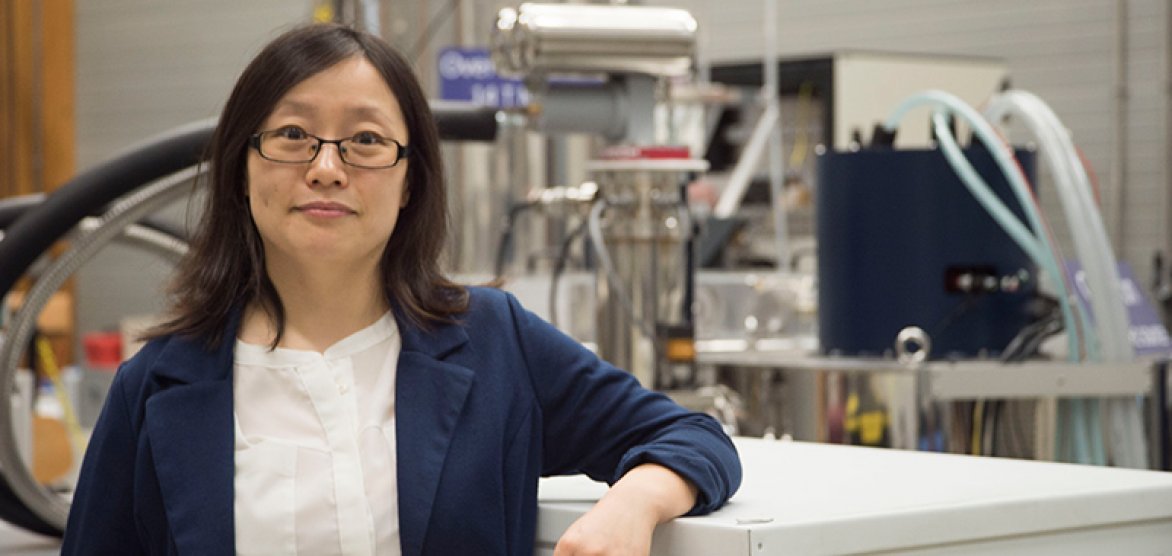A good defect: Sounds like an oxymoron, right?
Not to Yan-Yan Hu.
Turns out, in the kind of compounds Hu studies at the National MagLab, you’ve got your good defects and your bad defects. And, thanks to a prestigious award, Hu will be spending the next five years learning how to tell the difference and how to use that knowledge to build better batteries.
Hu, an assistant professor in Florida State University’s Department of Chemistry and Biochemistry, has received a highly competitive CAREER award from the National Science Foundation for her significant early career accomplishments in research and education. One of two MagLab scientists honored this year (physicist Christianne Beekman was the second MagLab recipient), Hu will study compounds that may end up in next-generation lithium batteries.
Along the way, she and her team will make lots of “mistakes,” most of them on purpose. That’s because, in order to create the best performing materials, they need to find the best way to mar their otherwise perfect crystalline structures.
“Why do we care about defects?” Hu asked. “Because, in certain materials, we do need to create defects to make them function.”
The big idea
Hu wants to understand better how to engineer materials so that they can effectively conduct ions for energy storage in fuel cells, batteries and capacitors. Today’s lithium batteries feature liquid electrolytes between the two ends of the battery, which provide a very efficient pathway for ions to travel, generating electricity. But these batteries have been known to start fires. That’s why Hu has been investigating ways to create an electrolyte out of solid materials such as glass and/or ceramics that contain fast-moving lithium.
It would definitely be safer. But would it work as well?
As she considered that question, Hu grabbed a ceramic pencil holder on her desk and rapped on it with her knuckles.
“The thing is, these are solid, right?” she said. “Intuitively, ion transport will be much slower in solids than in liquids. The goal is to create new materials that have really fast ion conduction, almost as good as liquids.”
And if tweaked just so, Hu said, these materials could be both safe and effective. That’s where the defects come in. If, when building these crystals atom by atom, you switch things up a bit (a misplaced chlorine atom here, a few missing lithium ions there), you can introduce imperfections in the lattice that end up changing the material’s property. And if designed and executed correctly, these defects can improve its performance. In the case of the lithium-based compound Hu is studying, the right defects could provide a preferred path for moving ions, boosting conductivity.
The process
So how exactly do you turn a crystal from a dusty, rural road into an ion freeway?
Here’s Hu’s plan.
First, bring in the theorists. Hu is collaborating with theoretical chemists who are using computer simulations to design and test the best ways to louse up the lattice. Different types of defects could be introduced, in different concentrations and locations. The theorists consider all the variables and come up with the recipe predicted to yield the highest conductivity.
Next, Hu’s team tries to turn these ideal systems into reality. “We do the synthesis and try to create the kind of defects that were designed by the computer,” she explained.
Third, they will measure how close they came to the theoretical model. This is called characterization – figuring out the precise structure of the materials they made. Scientists who characterize crystals often use neutron or X-ray diffraction. But for this project, Hu is using the high-field nuclear magnetic resonance spectroscopy and imaging (NMR/MRI) tools at the National MagLab, which are better at probing material defects and at detecting lithium.
Then, Hu will use those instruments to observe how well ions actually travel through the defect-laden material. For this she will use a special technique, called tracer-exchange NMR, developed by her group.
“You observe which defects the ions go through, in order to distinguish the functional defect from the defects that don’t boost performance,” she explained. “That gives you an understanding on what kind of defects will be helpful.”
OK. So by this time, Hu’s team will have: created a theoretical model; engineered a material based on that model; characterized those crystals to ensure that they built what they intended to build; then measured ion transport using high-resolution NMR.
But there’s one more test the team will conduct before concluding how well that particular recipe worked. They will put the material inside a battery; put the battery inside the world’s most powerful MRI magnet; then observe how well the compound functions as an electrolyte inside the device it was designed for.
“We watch the batteries in action,” said Hu of the technique, called in operando MRI. “We want to watch in real time what is happening. In many cases, transient processes that occur during the charging and discharging of batteries are actually the most important ones, which determine whether the device works or not.”
This extra step not only helps the team confirm if the material works when integrated into a device; it also sheds light on why it works — or why it doesn’t.
Until recently, scientists studying the structure of certain materials focused on solving the precise, idealized structure of the crystal lattice. Zooming in on the tiny defects is much harder. But it’s now clear, said Hu, that it’s worth the effort.
“It’s very challenging to characterize defects, to understand them and to predict how they behave,” Hu explained. “But with the development of new characterization tools and new computational tools, people are now ready to jump into this very challenging area of research.”
To learn more about Hu's research, visit her group's web page or read Studies of Functional Defects for Fast Na‐Ion Conduction in Na3−yPS4−xClx with a Combined Experimental and Computational Approach in Advanced Functional Materials (January 2019).
Story by Kristen Coyne



